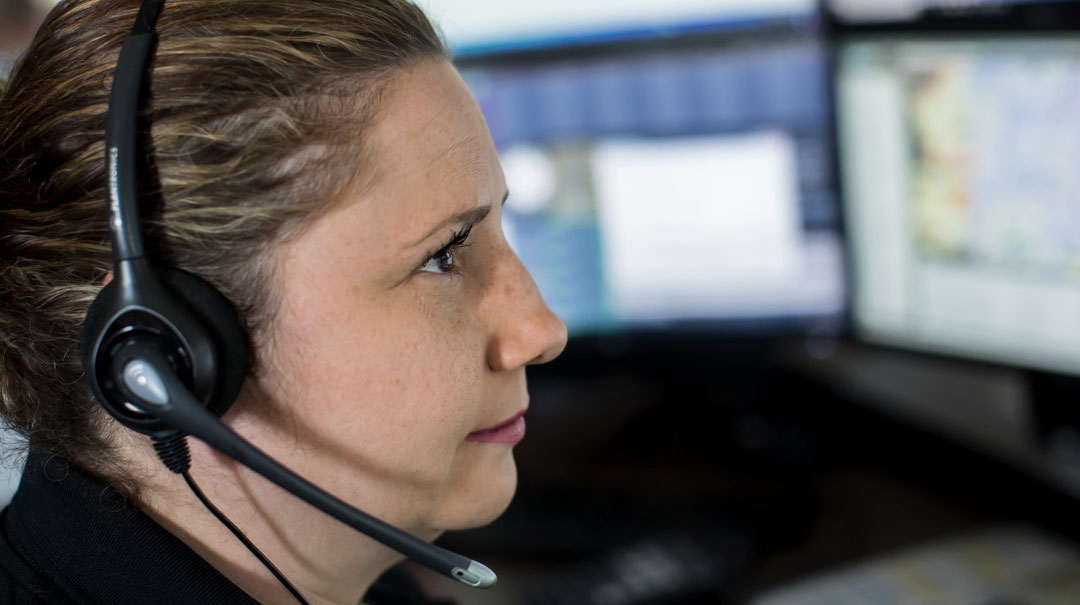For call takers, there’s often a sense of helplessness when details aren’t as clear as they could be, causing many to experience a lack of closure after a critical 9-1-1 call. The need for technology to fill the gaps and provide them a better experience has never been greater. This isn’t only for call takers’ mental well-being, but also to enhance their abilities to serve their communities. Public Safety Answering Points (PSAPs) are realizing this ‘better experience’ through the acceptance of visual content and the real-time transcription of 9-1-1 calls.
Visual Content
Okaloosa County Sheriff’s Office (OCSO) is the first county in Florida and among the first in the U.S. to implement Motorola Solutions’ CommandCentral Citizen Input. This cloud-based service allows call takers to receive images or streaming video from 9-1-1 callers in a controlled environment. Christine Cooper, 9-1-1 Coordinator for OCSO, shared that call takers now have a broader picture of what’s happening at the scene. “Citizen Input provides clarity of what the call taker is trying to get from the caller.” They can request the caller send visual content, and Christine said, “having this detail removes any doubt in determining what’s really happening.”
OCSO Asst. Communications Director Audrey Adams said having the visual content offers call takers a “sense of security” when dispatching first responders to the scene. “This media serves as an evidentiary point. Call takers gain a true perspective of what they’re sending first responders into, as well as a sense of closure they didn’t have before.” Audrey agreed the evidentiary point also serves to corroborate varying eyewitness accounts.
Just as important, this improved experience for call takers also extends to benefit callers. Not only does it give citizens another “tool” to communicate with public safety, Christine said, “Citizen Input creates a personal link between the caller and call taker that wasn’t there before. Being able to request this information makes us seem more receptive to what the caller is feeling. We come across as more proactive and create a stronger bond between our agency and the public.”
Both Audrey and Christine acknowledged that receiving visual content could place additional stress on call takers, a common concern among PSAP personnel. It’s why D. Jeremy DeMar, Executive Director, Mountain View Emergency Communications, New Jersey, emphasizes the need for stress mitigation and treatment surrounding acceptance of “incident related imagery (IRI).” This is the topic Jeremy studied extensively for his thesis for Naval Postgraduate School, Monterey, Calif. He is a proponent for PSAPs to engage with their communities via digital means – early.
“So many folks have wireless devices in their hands and want to interact with public safety entities using digital mediums. My primary focus is to get dialogue going and to talk about the advantages of early deployment. PSAPs don’t want to be the first, and they don’t want to be the last. But when PSAPs wait to see what will happen, they create a situation where they will be forced into the position, which is a far more dire situation to be in.”
Audrey and Christine have yet to encounter any stress issues related to receipt of the visual content. “We made everyone aware of the possibility they could get images, and they don’t have to view them,” said Christine. “Citizen Input automatically sends the visual content to storage. We are in the process of finalizing our formal policy now.”
Real-time Transcription
Management and call takers at the Memphis Police and Fire dispatch centers, Tenn., are realizing a better experience with another cloud-based service from Motorola Solutions — CommandCentral Smart Transcription. This service takes the voice audio from a 9-1-1, non-emergency or administrative call and transcribes it into a searchable text transcript. Call takers benefit from a lesser burden on their working memory of locations, suspect details, weapons, vehicle descriptions and more since they have access to a visual reference of the conversation as it is happening. Plus, being able to search the transcript to find these details to relay to first responders, 9-1-1 Director Raymond Chiozza said, gets their call takers “excited.” Yet, call takers aren’t the only staff gaining efficiencies.
As a supervisor, Raymond appreciates the increased situational awareness Smart Transcription has enabled. “I can log in from home or the office and look at calls coming in and look at certain things that occur between our multiple police and fire PSAPs. It’s a valuable tool for supervisors, particularly the ability to specify and refine lists of keywords to automatically search for within a call.
Smart Transcription also acts as a training tool by offering trainees a tangible reference to focus on in learning the appropriate way to interact with callers, officers and systems. Raymond explained, “When a training officer has several new candidates, he or she can tell all trainees to log in and go to one call to listen and describe what was wrong with the call.” Listening and seeing the transcription away from the PSAP and in a training room helps teach the new material and sharpen critical thinking skills, a capability Raymond described as “unbelievable.”
Raymond also remarked on the better experience outside of 9-1-1. The City’s emergency operations center (EOC) is located in a separate building, and its personnel have received logins for Smart Transcription. With a high interest in COVID-19, users have assigned related keywords and search for calls specific to the pandemic. In addition, Smart Transcription assists in investigations since detectives can search transcripts for key vehicles, suspects and location history, and patrol officers can retrieve post-incident details for writing up reports. The transcripts are preserved in long-term secure storage that makes post-call analysis possible.
The benefits both inside and outside the PSAP are many, and Raymond attributes much of their success to Smart Transcription’s cloud-based platform. “We love the cloud with no hesitancy. Many people don’t understand cloud; they don’t know they’re using some form of the cloud already. If your PSAP has firewalls and a network person to set it up correctly, you can open your PSAP up to so much more.”
To learn how CommandCentral Citizen Input and Smart Transcription offer call takers a better experience, join us on February 18th for a webinar in which we’ll demonstrate how these new cloud-based subscription services work, and you’ll hear more from your peers at Okaloosa County and Shelby County on their experiences with these solutions.
For more information visit us at www.motorolasolutions.com/ng911




